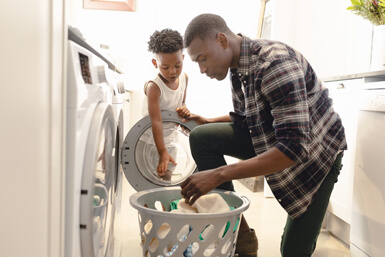How Much Energy Does My Dryer Use?
It's hard to imagine daily life without some of the major appliances we tend to take for granted, like HVAC systems and refrigerators. But when it comes to clothes dryers, the alternative isn't so unfathomable. We've all seen laundry strung up on a clothesline before, and maybe you've even done it yourself -- even if it was just a single garment slung over a shower curtain rod.

Clothes dryers are all about saving time. When you can't wait all day for clothes to dry on the line, you throw them in the dryer and they're ready to fold within an hour. But how much does that convenience cost you?
How Much Energy Does a Clothes Dryer Use?
Compared to most of the appliances around your home, your dryer probably consumes a lot of energy. This is true of most heat-producing appliances like your furnace, water heater and oven.
All dryers use electricity to power a motor that turns the drum and a fan that blows hot air. Some modern models may also use a tiny bit of electricity for digital displays and control panels. But most of a dryer's energy goes into producing heat, and this is done with either electricity or natural gas.
How Much Electricity Does an Electric Dryer Use?
Electric dryers span a wide range of wattages, from about 2,000 to 6,000 watts. That translates to about 2 to 6 kilowatt-hours of electricity. Based on the national average rate of 12 cents per kilowatt-hour, each hour of electric drying will cost somewhere between 24 and 72 cents, depending on the model.
How Much Energy Does a Gas Dryer Use?
Gas heat is measured in British thermal units (BTUs) and most gas dryers are rated for a level of BTU output that they never actually use. For example, most GE gas dryers are rated for 22,000 BTU per hour, but because the heat turns on and off during the course of a drying cycle, they may use as little as half that amount during a typical cycle. With natural gas prices hovering at just over one dollar per 100,000 BTU, the cost per load in a gas dryer is usually substantially lower than that of an electric dryer -- often about three times lower. Keep in mind that gas isn't the only operating cost; the motor and fan still draw some electricity.
Which Dryer Is Right for Your Home?
If your home is already connected to natural gas with hookups in the laundry room, you'll typically save energy and money in the long run with a gas dryer. This tendency is based in part on the relatively low, stable price of natural gas in most areas, so if you live in an area with unusually high natural gas prices, this might not be true for you. If your home doesn't currently have a natural gas connection, it probably isn't cost-effective to undergo an expensive natural gas conversion just so you can dry with gas.
How Much Electricity Does a Dryer Use Per Load?
If you have an electric dryer and you know how many watts it draws, there's a simple calculation you can use to estimate your cost per load:
- Verify your dryer's wattage. You can find this information on the "UL" label somewhere on your dryer. You can also look in your dryer's original documentation or search online with a product number to find the wattage on a manufacturer or retailer website.
- Estimate the length of a typical drying cycle. Because dryers vary in size and heat output, some dryers may take 45 minutes per load, while others may take an hour and a half.
- Take the cycle length as a percentage of one hour and multiply it by the dryer's wattage. For example, if your drying cycle is 45 minutes, that's the same as 75% of an hour, or .75 of one hour. If you have a 5,000-watt dryer, multiply .75 x 5,000 = 3,750 watts.
- Multiply the kilowatt-hours by the kWh rate on your last electric bill. If your rate is 12 cents per kWh, .12 x 3.75 kWh = .45, or 45 cents per load.
How to Reduce Your Dryer's Energy Consumption
Feeling a bit of sticker shock after calculating the cost per load to use your dryer? There are a few things you can do about it.
If you're in the market for a new dryer anyway, you can start by shopping for an energy efficient model. Look for the ENERGY STAR logo and read the black and yellow ENERGY GUIDE labels when shopping online or at retail. Also, be sure to choose a model with a moisture detector that automatically ends the cycle when clothes are dry. And if you'll also be replacing your washer, take a few minutes to learn about how much energy washing machines use and how to choose an efficient model.
Here are a few additional tips:
- Hang-dry your clothes whenever you can. For apartment dwellers, lack of outdoor space is often the main obstacle to hang-drying, but there are foldable drying racks that can hold about a half load of laundry each. Keep in mind that drying clothes indoors will add a little humidity, so it may not be a good strategy in spaces where dampness is already an issue.
- Clean the lint trap after every load. This keeps your dryer running efficiently and helps prevent fires.
- Don't overstuff the dryer. If there's no room for warm air to circulate through the clothes as they tumble, the load will take far longer to fully dry.
- Dry multiple loads in a row. If you start a new load as soon as you finish the last one, you'll save the residual heat from the previous cycle and help the next load dry faster.
- Dry similar items together. Light fabrics, like t-shirts and boxer shorts, dry faster than thick fabrics like towels and warm socks. By drying loads of similar thicknesses, you can avoid overdrying.
- Do laundry when it's cheapest. If you're eligible for time-of-day pricing, free energy weekends or a similar pricing perk from your electricity provider, save your laundry for when rates are lowest.
 CANADA
CANADA USA
USA
